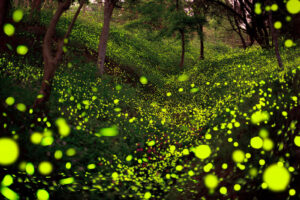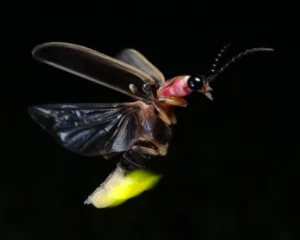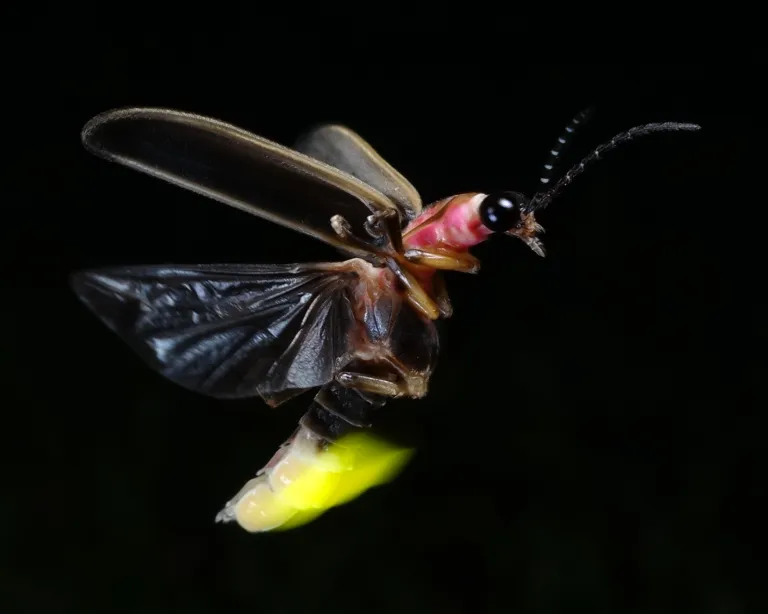Introduction
Fireflies, or lightning bugs, are synonymous with magical summer nights. Their gentle glow illuminates fields and forests, captivating both young and old. But beyond their enchanting lights lies a fascinating world of biology, communication, and ecology. In this article, we explore the science of fireflies, their life cycle, ecological role, cultural importance, and the challenges threatening their existence.

Fireflies lighting up a field on a summer night.
The Science Behind the Glow
Fireflies are beetles belonging to the family Lampyridae. Their bioluminescence is a result of a chemical reaction involving luciferin, luciferase, ATP, and oxygen. This reaction creates “cold light,” meaning nearly 100% of the energy is emitted as light instead of heat.
Each firefly species has unique flash patterns. These patterns act as a form of communication, primarily for mating. Males emit specific light sequences to attract females, who respond with corresponding flashes.
Fun Fact: Fireflies are among the few organisms that produce cold light!

Close-up view of a glowing firefly’s abdomen.
The Life Cycle of Fireflies
Fireflies undergo complete metamorphosis, which consists of four stages: egg, larva, pupa, and adult.
- Egg:
Female fireflies lay eggs in moist soil. Some eggs even emit a faint glow to deter predators. - Larva:
Known as glowworms, firefly larvae are predatory, feeding on snails and slugs. This stage can last up to two years. - Pupa:
Larvae pupate in the soil and undergo metamorphosis to emerge as adults. - Adult:
Adult fireflies focus on reproduction. Their lifespan as adults is short, lasting only a few weeks.
Firefly life cycle showing transformation from egg to adult.
Ecological Importance of Fireflies
Fireflies are more than just a magical sight; they are essential contributors to maintaining ecological balance. Their roles include:
- Predation
Firefly larvae, known as glowworms, act as natural pest controllers by feeding on slugs, snails, and other small invertebrates, benefiting agricultural and garden ecosystems. - Prey
Fireflies are a vital food source for birds, amphibians, reptiles, and other insect-eating animals, supporting biodiversity in their habitats. - Environmental Indicators
As sensitive organisms, the presence of fireflies reflects the health of their environment. Their decline often signals issues such as pollution or habitat degradation, making them crucial bioindicators.
Fireflies are integral to the food chain and ecosystem health, emphasizing the need to protect their habitats for ecological stability.
Do visit these too:
- Missouri Bird Flu Case: Unprecedented Infection Sparks Urgent Health Concerns
- The Future of Electric Vehicles: What to Expect
- 9 Best Books to Gift This Holiday Season
Cultural Significance of Fireflies
Fireflies have inspired cultures worldwide. In Japan, they symbolize the fleeting nature of life and are celebrated during summer festivals. In the United States, they evoke memories of childhood summers and are celebrated in art, literature, and festivals.
Fireflies, once abundant in many regions, are now facing significant threats that endanger their existence. The key factors contributing to their decline include:
- Habitat Loss
Urbanization, deforestation, and land conversion for agriculture destroy the moist environments fireflies rely on for breeding and development. Without these habitats, firefly populations struggle to thrive. - Light Pollution
Artificial lights from urban areas disrupt fireflies’ natural mating signals, making it difficult for males and females to communicate and find mates. This interference significantly reduces reproduction rates. - Pesticides and Pollution
Widespread use of chemical pesticides in agriculture harms fireflies directly and kills the invertebrates they prey upon. Pollution from industrial runoff further degrades their habitats, making survival challenging. - Climate Change
Rising temperatures, altered rainfall patterns, and other climate changes disrupt firefly life cycles and breeding patterns, pushing some species toward extinction.
The decline in firefly populations highlights the need for conservation efforts focused on preserving habitats, reducing artificial light, minimizing chemical use, and addressing climate change impacts. By mitigating these threats, we can help protect these magical creatures for future generations.
External References for Firefly Conservation and Research
- Firefly Conservation & Research
- Firefly.org: Protecting Fireflies for Future Generations
- The Science of Firefly Bioluminescence
- Smithsonian Magazine: How Fireflies Glow
- Threats to Fireflies
- National Geographic: Fireflies Are Losing Their Habitat—And They’re in Danger of Disappearing
- Climate Change and Fireflies
- Scientific American: Climate Change Threatens Fireflies
- Cultural Significance of Fireflies
- Japan Times: Fireflies—A Symbol of Summer in Japan
- Citizen Science for Fireflies
- Mass Audubon: Firefly Watch Project
How to Help Save Fireflies
Steps You Can Take:
- Reduce Light Pollution: Use motion-sensor lights and reduce outdoor lighting during peak firefly activity.
- Create a Firefly-Friendly Yard: Maintain moist soil and plant native vegetation.
- Avoid Pesticides: Switch to natural pest control methods.
- Support Conservation Efforts: Participate in local initiatives to restore habitats.

The Future of Fireflies
Fireflies symbolize the fragile harmony of nature, captivating us with their enchanting glow. Protecting them requires collective efforts to address habitat loss, light pollution, and environmental changes. Each small step we take—whether creating firefly-friendly spaces, reducing artificial lighting, or supporting conservation initiatives—can help safeguard these magical creatures.
Their glow is more than a source of wonder; it’s a reminder of our responsibility to preserve the natural world. By acting now, we ensure that future generations can experience the beauty and magic of fireflies lighting up summer nights.


